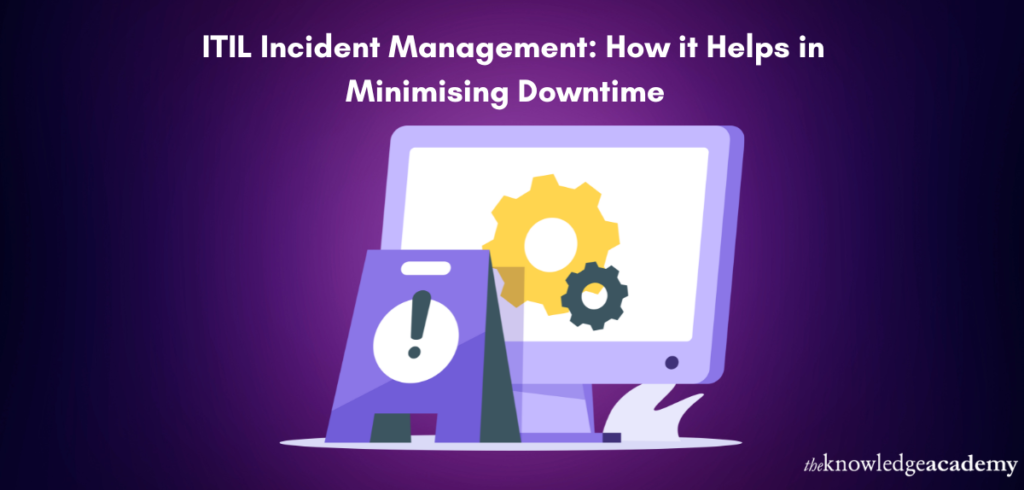When was the last time an unexpected IT disruption made your team scramble? In today’s tech-driven world, downtime is the enemy of productivity and customer satisfaction. That’s where an ITIL Certification can make all the difference.
By mastering ITIL Incident Management, your team can tackle IT issues efficiently, reducing disruption time and keeping your operations running smoothly. But how do you ensure these incidents are managed swiftly and with minimal impact? Let’s dive into the ITIL incident management formula and explore how to minimise downtime before it even begins.
What is ITIL Incident Management?
ITIL (Information Technology Infrastructure Library) is a collection of best practices to help businesses manage their IT services. A crucial component of this methodology, ITIL incident management focuses on quickly and efficiently handling and resolving IT events.
In ITIL, an incident refers to any unplanned interruption or degradation of an IT service. Incident management aims to restore normal service operations as swiftly as possible, ensuring minimal disruption to business operations. By adopting a systematic approach to incident management, organisations can reduce the downtime that impacts customers and clients.
Why Minimising Downtime is Critical?
Whether planned or unplanned, downtime disrupts business continuity and can have severe consequences. Extended downtime can result in lost revenue, a decline in consumer trust, and even damage a company’s reputation. Reducing downtime is essential for maintaining a competitive edge, as businesses rely heavily on continuous IT services in today’s fast-paced world.
Moreover, downtime leads to higher operational costs. The longer the outage, the more expensive it becomes in terms of resource allocation, troubleshooting, and recovery efforts. This is why having a robust incident management plan is critical to resolving issues and anticipating potential problems before they escalate.
The ITIL Incident Management Process Explained
The ITIL incident management system is based on a series of clearly defined actions that guide businesses from detecting an incident to its resolution. This system is designed to be repeatable and efficient, ensuring incidents are handled systematically. The main phases include:
- Identification and Logging: The first step in the incident management process is identifying and documenting the occurrence. Monitoring tools, user reports, or automatic alerts help with this. Accurate logging is essential for effectively tracking and prioritising incidents.
- Categorisation: Once an incident is detected, it must be categorised based on its impact and severity. This helps determine its priority and whether escalation is necessary. Proper classification ensures that resources are allocated efficiently and that high-priority incidents are addressed first.
- Diagnosis and Resolution: The next step is determining the cause of the incident and implementing a solution. Depending on the complexity, this may require an in-depth investigation or a simple fix. The goal is always to resolve the issue quickly and restore normal operations.
- Closure and Documentation: After resolving the incident, it’s crucial to document the resolution and close the event. This step ensures the problem is thoroughly addressed and provides an opportunity to review the incident for future improvement and learning.
How ITIL Incident Management Minimises Downtime?
So, how does ITIL incident management specifically help reduce downtime? The key lies in its proactive and methodical approach to handling events.
By following the ITIL framework, businesses can detect and resolve incidents faster, ensuring that IT services are restored promptly. ITIL also enables companies to:
- Establish Efficient Incident Classification: This ensures that the most critical incidents are prioritised and resolved first, minimising the impact on essential services.
- Define Clear Communication: Well-defined communication channels enable faster event resolution, as every team member knows their responsibilities.
- Analyse Past Events: Reviewing past incidents helps businesses identify recurring issues and take preventive measures to avoid similar disruptions in the future.
In the end, the incident management system of ITIL enables businesses to act quickly, decisively, and effectively, minimising the time required to restore normal service and reducing the overall impact of IT disruptions.
Conclusion
Minimising downtime is essential for businesses to maintain smooth operations, customer satisfaction, and profitability. By implementing ITIL incident management best practices, organisations can quickly and efficiently resolve incidents, ensuring that any disruptions are short-lived. Consider The Knowledge Academy courses to advance your knowledge in ITIL incident management.
Want more insights? Keep visiting Lotology for the latest updates and information!

